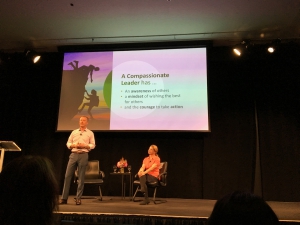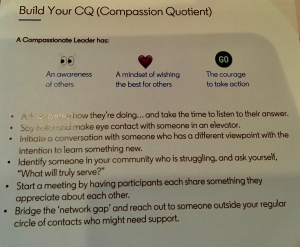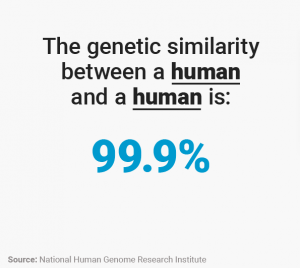Compassion in leadership is an emerging concept in corporate management, brought to the forefront by LinkedIn in CEO, Jeff Weiner. But for most of us, the concept may be a bit fuzzy and theoretical. I was interested in learning more because I teach Leadership Communication at San Francisco State University. At the recent Compassion in Leadership Summit at the Computer History Museum, I gained a much clearer understanding, so here I have captured 10 hours of content for you to read in the next 5 minutes. The key takeaway is that leaders need to develop three core compassion skills and organizations need to develop systems that foster compassion.
Compassion = Empathy + Action
Put simply, compassion is where empathy meets action. Empathy is feeling what another person is feeling, while compassion is putting yourself in the shoes of another for the purpose of alleviating suffering. As Jeff Weiner explains, if you see somebody being crushed by a boulder, empathy is feeling the crushing feeling in your chest as they suffer. Compassion is understanding their suffering based on a past painful experience you had and then finding a way to get the boulder off them.
The 3 Skills of a Compassionate Leader: Awareness, Mindset, Action
Scott Shute, Head of Mindfulness and Compassion, LinkedIn defines compassionate leaders as having the capacity for awareness of others, a mindset of wishing the best for others, and the courage to take action. Lori Schwanbeck, Co-founder of Mindfulness Therapy Associates, reminds us that humans are wired for compassion, but the environment in which we are raised activates different levels of capacity. The good news is that we can all expand our capacity for compassion. In each of the three leadership skill areas, there are items that limit or expand our capacity for compassion.

3 Skills of the Compassionate Leader
Awareness of others means being present to what is happening for the other people in our environment. Capacity for awareness can be limited by our propensity as humans to orient to ourselves as a matter of survival and by the overactivity of our sympathetic nervous system. We may incorrectly perceive what is happening around us as a ‘flight or fight’ situation, activating the sympathetic nervous system and limiting our brain’s executive functioning. Capacity for awareness can be expanded by self-regulation of emotions, a sense of curiosity, and through the practice of noticing others.
Our mindset affects how we act and how we treat other people. Because as humans we are always pattern matching and connecting new information to what is already in our brains, we tend to relate to people as if they are actually the story that we’ve created about them in our head. If they are wearing a business suit our story may be that they are ambitious. If they are in tattered clothes, our story may be that they are disadvantaged. Depending our story, we will treat that person more or less compassionately. Therefore, a mindset of wishing well for others is an important skill for compassion in leadership. The mindset of wishing well for others can be limited by fear, competition, lack of trust, and differencing through ‘not-like-me’ thoughts. Our capacity for wishing well for others can be expanded by seeing others as ‘like-me’ with common humanity, through gratitude, and by celebrating other’s success and happiness.
The courage to take action means being willing to be uncomfortable, to step into another’s shoes, see things from a different perspective, and possibly acknowledge our own weaknesses. This courage can be limited by overwhelm, apathy, self-promotion, and time pressures. We’ve all been in situations where we see a coworker who might need help but are in too much of a hurry to meet our own project deadline to stop and help. That is time pressure limiting the courage to take compassionate action. The courage to take action can be expanded by setting intentions, taking small steps, and connecting with an accountability buddy. An example is setting the intention to ask a coworker how they are doing and then deeply listen to their answer. With that intention we will gain the courage to take that action, even when we are rushed.
During the conference we practiced exercises in noticing, connecting, and thinking of actions to take as a means of building up our Compassion Quotient (CQ). As Scott Shute said, “A few breaths put us in the performance zone and opens our aperture to other people.”
Organizational Systems can Foster Compassion
“Smart companies know that doing well and doing good go hand and hand, and as our CEO says, ‘the business of business is to improve the state of the world’,” Ebony Beckwith, EVP & Chief Philanthropy Officer, Salesforce.
“Investing in others’ success is investing in your success and the organization’s success,” Jeff Weiner, CEO, LinkedIn.
A business that is both doing well and doing good, and also highlighting the importance of individual success for overall organizational success, is likely to have systems in place that foster compassion. Christina Hall, SVP and Chief People Officer at LinkedIn commented that it is not just the typical Silicon Valley perks that are part of the company’s effort to treat employees compassionately. It also includes things like long leave times with counseling and building inter-work relationships. LinkedIn uses Glint to survey employees and hear directly what they want and don’t want. The answer to a question about what people wanted to see in the manager one-on-one meetings was phones off and laptops closed. That led to a new system for meetings, a system that increased compassion and employee engagement and supported one of LinkedIn’s codified values: Relationships Matter.
Ebony Beckwith of Salesforce also mentioned the significance of relationships, particularly the importance of leaders being clear with people – clear about goals, expectation, what is working and what is not. “Clear is kind, unclear is unkind. Being a compassionate leader is having the courage to be clear with people,” she commented. Open communication is a common theme of many systems that foster compassion in organizations. “When you share, it opens up others to share,” Ebony added.
Another interesting organizational system, that we might not associate with building compassion, is business success measurement. Mohak Shroff, SVP of Engineering at LinkedIn told a story about a change in the system of success measurement. The original measurement system tracked and maximized productivity. Productivity went up, but people complained. The new system of measurement maximized for happiness. Happiness, productivity, retention, and recruiting all went up and complaining went down.
Other system ideas shared included starting meetings with team members sharing one thing they appreciated about each other and having a section of all-hands meetings focused on recognizing compassionate actions of leaders and employees.

Hopefully this short summary of the Compassion in Leadership Summit made the concept clear and sparked ideas for implementation. As the conference host Soren Gordhamer said, “Wisdom and compassion are two wings of one bird.”



